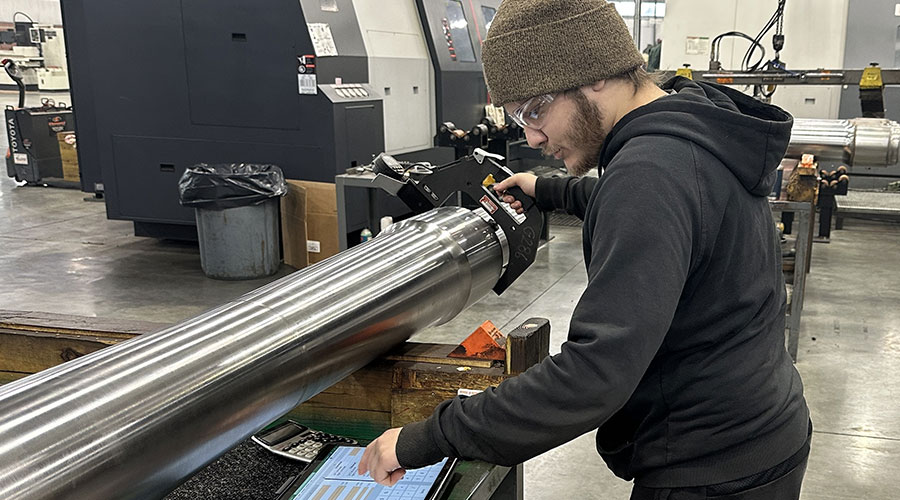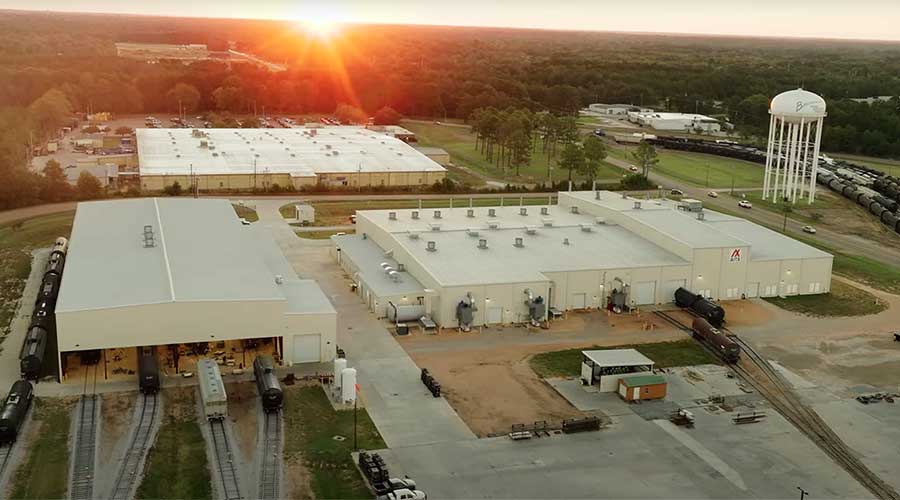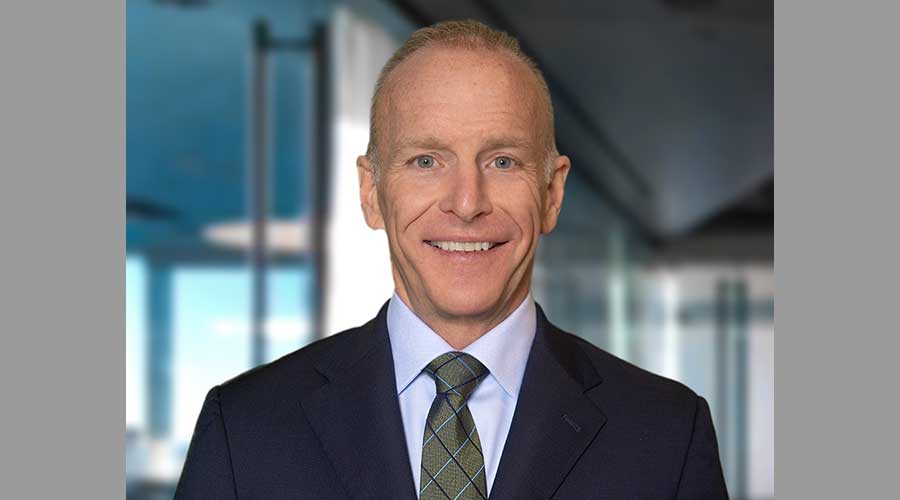Stay updated on news, articles and information for the rail industry
June 2014
Rail News: Mechanical
Locomotive engine upgrades reflect pending emission regulations, evolving fuel trends
— by Angela Cotey, Senior Associate Editor
For more than a decade, diesel engine technology enhancements have helped railroads significantly cut fuel consumption and reduce emissions. Engine manufacturers have overhauled their products to meet Tier 1, then Tier 2, then Tier 3 emission standards as regulated by the U.S. Environmental Protection Agency. And now, those manufacturers are facing one of their greatest challenges yet: creating an engine that slashes particulate matter by 70 percent and nitrogen oxide (NOx) emissions by 76 percent from the current Tier 3 emission levels. The Tier 4 regulations will take effect Jan. 1, 2015.
The pending regulations aren’t the only thing keeping manufacturers on their toes. Many railroads are exploring the possibility of transitioning from diesel- to natural gas-fueled locomotives, and need engines that can run on both. They also continue to seek options for remote diagnostic capabilities. To that end, many suppliers are launching new products and tweaking existing ones to address regulatory issues and help railroads achieve their locomotive-efficiency needs.
Since introducing the Tier 2-compliant Evolution® Series locomotive in 2005, GE Transportation has upgraded the platform to meet Tier 3 emissions regulations and provide increased fuel efficiency. Now, the company is testing the Evolution Series Tier 4 locomotive.
“We haven’t changed the base platform, so we’re not really changing the engine itself,” says Tina Donikowski, GE’s vice president of Locomotive, Marine and Stationary Power & Drill.
The units will meet Tier 4 regulations without the use of aftertreatment, a system of filters, converters and chemicals that work like a catalytic converter in an automobile, says Edward Hall, engineering leader for GE’s engine development group. Instead, GE designed the engine using a combination of exhaust gas recirculation, air handling and high-pressure fuel system advancements, according to the company.
Two units have been in testing since last year and recently were sent — along with three other locomotives fresh off the production line — to Union Pacific Railroad, which will test them through summer’s end, says Heavy Haul Product Leader Len Baran. By year’s end, GE plans to send 20 pre-production Evolution Series Tier 4 locomotives to BNSF Railway Co. for another two years of testing, says Donikowski.
In the meantime, GE is developing the NextFuel™ Natural Gas Retrofit Kit, which is designed to enable existing Evolution Series locomotives to operate with dual-fuel capabilities. A retrofitted control system could automatically recognize if natural gas or diesel is being pumped into the engine, which then would be tuned accordingly, Baran says.
“With natural gas, it’s not the mechanics that are challenging; it’s the software and control strategy — what to inject, at what rate and what notch is the locomotive going out at when we do it,” adds Donikowski.
The NextFuel kit would provide a gas substitution rate of up to 80 percent, she says. GE recently shipped some demonstration kits to BNSF, which will test them for three to six months.
GE also is analyzing ways it can better use data obtained from the engine itself.
“There is all this information we can get from the systems and today, we only use the most basic form of it to keep the system running,” says Hall. “But if you look at that data in detail, you can start to optimize the system and get that last 1 percent of fuel efficiency, or use it in a diagnostic mode so you can tell what parts are going to go bad and when.”
Delving deeper into diagnostics
Researchers at Progress Rail Services subsidiary Electro-Motive Diesel Inc. (EMD) also are developing diagnostic technology.
They’re collaborating with officials at parent company Caterpillar Inc. to determine ways the company can use information collected from locomotive sensors to predict when locomotive or engine parts might fail, says Progress Rail Senior Vice President and Chief Marketing Officer of Locomotive and Railcar Services Marty Haycraft.
Progress Rail also is trying to push the R&D envelope with its efforts to develop natural gas products for its rail customers. Caterpillar and EMD engineers have developed a Dynamic Gas Blending dual-fuel technology that enables Caterpillar diesel engines to burn liquefied natural gas at a substitution rate of up to 60 percent.
The technology can be used with existing gas engine hardware, with no changes to the existing diesel engine or diesel engine components, according to Progress Rail literature.
“It’s being tested and will be out in the very near future running on North American railroads,” Haycraft says.
Caterpillar engineers also are developing a High Pressure Direct Injection (HPDI) system that has a 95 percent substitution rate. The technology introduces gas at high pressure directly into the combustion chamber of a diesel engine, allowing for a small amount of diesel as the ignition source and large amounts of gas to be delivered directly to the engine cylinder.
“You wouldn’t be able to go back and forth between diesel and natural gas without changing some hardware on the engine, but if your goal is to have a high substitution rate with natural gas, HPDI is your technology,” says Haycraft, adding that the system is scheduled to be available in 2017.
Tier 4 emissions regulations are top of mind for Progress Rail officials, too. The company is manufacturing a series of EMD F 125 low-emission passenger locomotives for Southern California’s Metrolink.
Designed to meet Tier 4 regulations, the units will feature a turbocharged, 20-cylinder, four-stroke Caterpillar C175 engine that includes a selective catalytic reduction (SCR) aftertreatment system designed to reduce NOx emissions.
Progress Rail will supply up to 20 locomotives to Metrolink, with delivery beginning in 2015.
The company also is “investing heavily” to develop a Tier 4-compliant diesel freight engine, says Haycraft.
“We’re well down the path as far as development goes, but we want the engine to be tried and true and tested ... before we introduce it to the market,” he says, adding that Progress Rail anticipates having the diesel freight engine on the market by 2017.
High speed, low emissions
Cummins Inc. introduced their Tier 4-compliant engine last fall. The 4,200-horsepower QSK95 Power Module is a self-contained unit that can provide ultra-low emissions capabilities for heavy-haul locomotives. The high-speed engine marks Cummins’ foray into the larger engine market, says Cummins Rail Market Business Analyst Ross Kunkler.
The power module was designed in partnership with Sygnet Rail Technologies L.L.C., which developed the power unit, says Kunkler. The unit features the QSK95 engine, alternator, cooling system and dynamic braking system, along with a Selective Catalytic Reduction (SCR) exhaust aftertreatment.
The aftertreatment system is “essentially a passive flow-through aftertreatment” that doesn’t trap or filter emissions in the exhaust stream, says Kevan Browne, Cummins’ global off-highway communications director. Rather, the system lets the exhaust stream flow as it typically would, but — with an injection of diesel exhaust fluid, also known as urea — creates conditions for the SCR catalyst to function and remove NOx from the exhaust stream.
“Because it’s a flow-through system, the aftertreatment is fundamentally very simple and requires no service or maintenance,” says Browne, adding that Cummins Emission Solutions manufactures the SCR aftertreatment, so “it’s fully integrated with the engine.”
Despite the addition of an aftertreatment system, Cummins engineers designed the QSK95 to fit within the standard space envelope available for an existing engine.
“It’s a high-speed diesel engine that’s being configured as a drop-in to replace a medium-speed engine,” Browne says.
This summer, the Indiana Rail Road Co. will begin field testing the engine in a repowered locomotive. The QSK95 is hitting the passenger-rail market, too, powering the Siemens Charger locomotives recently purchased by the state departments of transportation for Illinois, California, Michigan, Missouri and Washington. The states collectively ordered 32 of the diesel-electric locomotives from Siemens, which they will operate on intercity passenger-rail lines at speeds up to 125 mph.
In the meantime, Cummins continues to supply engines for generator sets, or GenSets, taking a multi-engine approach to power switcher locomotives. A multi-engine installation enables railroads to use two engines for smaller loads, or three engines for larger loads. The company is looking at how a multi-engine approach could be used for larger locomotives, Browne says.
After no aftertreatment
MTU America Inc. offers diesel engine technology for GenSets, switchers and line-haul locomotives, as well. The company’s latest product offering is the Series 4000 R54 engine, a Tier 3-compliant unit introduced in 2012. The Series 4000 R54 engine is available in a 12- or 16-cylinder version.
The engine is the lowest-emission, single-engine prime mover for the North American rail market that does not require the use of aftertreatment, says Bruce Wolff, MTU’s application engineer - rail engines. Instead, it uses a combination of cooled exhaust gas recirculation inside the engine to reduce NOx levels; a two-stage turbocharging system to ensure there is sufficient air available for efficient and low-soot combustion even in extreme temperatures or elevations; and a high-pressure common rail fuel injection that helps lower particulate emissions by more precisely controlling fuel injection.
MTU is in discussions with two Class Is that are interested in the engine. The company also is providing the Tier 2- and Tier 3-compliant engines to locomotive builders such as Brookville Equipment Corp., Knoxville Locomotive Works, Ohio Locomotive Works L.L.C. and Chattahoochee Locomotive Co.
MTU engineers are working to determine how to meet Tier 4 standards for their engines, likely by building on the technology used in the Tier 3-compliant engine, which currently meets all the Tier 4 regulations except for the NOx emissions, says Wolff. MTU will need to add an aftertreatment system to the R54 engine. But, because of the in-engine processes the company already uses on the product, SCR likely will only need to be used when the locomotive is operating in higher notches according to Senior Sales Manager — Rail Products Doug Berry.
“If you have SCR, you have SCR, but the railroads don’t want to use any more than they have to,” he says. “So if we can reduce the amount of urea they use in the process, it can extend the required intervals for refilling the urea solution.”
Maintaining regulations
Addressing Tier 4 regulations is equally important for John Deere Power Systems, which manufactures a line of diesel engines for off-highway applications, including power units for railroad maintenance-of-way equipment.
To meet the pending standards, John Deere is offering a range of Integrated Emissions Control system configurations, based on engine size. For the 48- to 74-horsepower range, engine models will use an exhaust filter that contains a diesel oxidation catalyst/diesel particulate filter (DOC/DPF) without cooled EGR or SCR.
In the 75- to 140-horsepower range, John Deere is offering the PowerTech™ PWL 4.5L engine, which features an Integrated Emissions Control System consisting of an SCR, diesel oxidation catalyst and cooled exhaust gas recirculation technology. By optimizing the combustion system and improving the SCR system conversion efficiency, John Deere was able to eliminate the need for a diesel particulate filter, according to company literature.
Engines operating at 125 horsepower and above will use a system comprising cooled EGR, a DOC/DPF and SCR.
To monitor its Tier 4 engines, the company in March introduced John Deere PowerSight™, a telematics system that features four components: the JDLink™ machine monitoring system, remote diagnostics and programming, machine health prognostics and the PowerAssist™ app. The technologies “integrate seamlessly” to help customers manage their John Deere-powered OEM equipment, according to the company.
PowerSight will have the capability to monitor an engine’s location, geofencing, service hours, maintenance alerts, idle time and fuel consumption.
Pending emission regulations aren’t only impacting engine manufacturers. Companies that supply other types of diesel engine technology, such as GenSets, also are working to re-engineer their products accordingly.
GenSet evolution
Stauffer Diesel Inc. has been manufacturing Railgen™ fully enclosed generator sets for passenger-rail cars under its Stadco Products Division since the early 1980s. The company also distributes engines for Deutz and Mitsubishi.
When GenSets hit the freight-rail market about a decade ago, Stauffer Diesel/Stadco engineers jumped at the chance to lend their expertise. In 2005, the company began designing and manufacturing GenSets, powered by a Deutz engine, for R. J. Corman Railroad Group subsidiary Railpower Locomotives.
The company works closely with Railpower to integrate the GenSet “pod” — which includes components such as the cooling system and exhaust mufflers — into the locomotive, so the pod can be put into place with minimal connections, such as to the engine and generator, fuel system and engine drain.
The company’s GenSets currently feature Deutz Tier 3 engines. When manufacturing Tier 4-compliant GenSets, the company will be able to use either Deutz or Cummins engines.
The Deutz engine will feature dual SCR and will not require exhaust gas recirculation (EGR), which means Stauffer will not have to increase the size of the cooling system when it builds the GenSet.
“It will basically be the same footprint, so if a customer is looking to replace an older unit, we can put in the Tier 4 unit with only minor changes,” Travis Stauffer says.
The Cummins engine will require an entirely new design process, but the company is “excited about the ability to give the customer a choice of product that meets their requirement,” he says.
It’s a goal that, as ever, all diesel engine technology providers are striving to meet.
Email comments or questions.


 LRW Honors Amtrak’s Acheson As Railway Woman Of The Year
LRW Honors Amtrak’s Acheson As Railway Woman Of The Year
 From Editor-In-Chief Foran: Of Gender Equity And Inclusion
From Editor-In-Chief Foran: Of Gender Equity And Inclusion
 Spotlight On Some Of Today’s Rail Safety Products
Spotlight On Some Of Today’s Rail Safety Products
 Women of Influence in Rail eBook
Women of Influence in Rail eBook
 railPrime
railPrime







